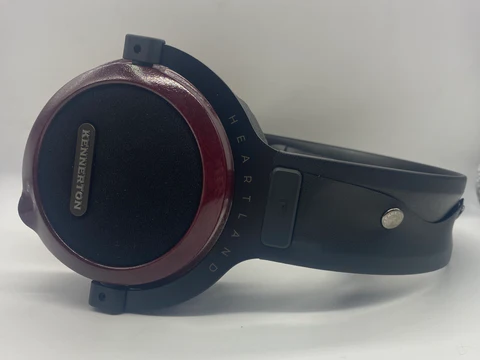Last year, Kennerton released the GH 40 and Rognir closed-back headphones. Now they are returning to high-end open-backs with the Heartland. This is a new planar headphone that will set you back $3469, entering the endgame territory of the hobby. Can it reach the heights of last year’s releases?
What You Get
- Kennerton Heartland Open-Back Planar Magnetic Headphones
- 2-meter Cable with 6.35mm Unbalanced Jack
- Carrying Pouch
- Soft Leather Carrying Case
- Certificate of Authentication
- Frequency Response Chart

Look & Feel
Kennerton headphones have a unique style of wooden headphones. The wood is always very thick and makes for a heavy-duty build. They find a good medium between making the Heartland look like an old relic and a durable product. Aesthetically, the Heartland is a home run. Its wooden earcups, steel frame, and meaty lambskin pads ensure a fantastic design mixed with great comfort. You may think that with these materials the Heartland would be a considerably heavy pair of headphones, but they’re aren’t far off from any other pair in its price range.

Design
Encased within the Heartland’s wooden housing is an 80mm planar driver. It’s made using carbon fiber tooling and a 20nm polyimide membrane. With such a large driver, it is best to have a good amplifier, but you won’t find much resistance from the Heartland at only 43 Ohms.
Soundstage
When playing your first track through the Heartland you are immediately introduced to its extensive stereo field. Its scope is displayed effortlessly, pushing the sound elements into the open air with a grand width. There is a clear sense of spatial identity with its imaging, as instruments and effects showcase accurate positioning and elegant movement. It never feels too floaty, but the stereo placement still acts free, not limited to an enclosed section of the mix. Even when considering all of its grace, the Heartland surprisingly keeps its headspace pretty tight. While the imaging feels open, certain elements never really come out too far. None of the layers presents themselves as forward. They only stack linearly which is not what I expected. However, the soundstage isn’t flat or plain. It feels alive and has a distinct breath to it, I just think I would have liked it more if that breath had more of a scale to it.
Low End
There are a lot of different sections to this bass that define themselves greatly. Starting off with the sub-bass, the timbre shows some impressive form. It’s clear and offers a smooth foundation for the frequencies to express themselves. It comes up softly from your throat and pools in your jaw with subtle detail. More vibration and rumble could’ve been expressed better here, but the calmness of this tone lends itself well to the right genres. Even with its slower response, the bass still offers a ton of volume. Great gain is added to the lows, showcasing just how well-tuned these frequencies are. Energy is kept up in the mid-bass, providing good punch and warmth to the sound signature.
Mids
The dominance of the mid-bass echoes in the low-mid frequencies. They show a darker timbre that enriches the fullness of the mids without adding any resonance that results in cloudiness. Its low-mid focus aims to add richness to the instruments and it mostly succeeds. Certain elements like distorted guitars and drums have a lively appearance. Many post-rock tracks have a distinct realism, especially with their pinpointed notes and roominess. Sometimes the roominess comes at a disadvantage though, as heavy reflections can make the mids appear a little disorganized. These frequencies aren’t as elegant, and it makes it harder for other elements to properly cut through. Thankfully, vocals don’t seem to get lost in the shuffle, and there is a more crisp accent to their performances.
Highs
Things start to calm down in the highs, adhering to a darker profile. The timbre here is softer but still articulate, even with some significant decreases in gain from the treble. There still feels like an abundance of frequency content here, and the extension of it helps bring out more detail and dynamic range. While you won’t get much texture from these highs, you can still expect to enjoy some graceful tone that is easy to digest.
Summary
The Heartland might be an acquired taste, but it’s one of the best headphones with its particular profile. It doesn’t have a sound that typical high-end open-back planar headphones have, so it’s a special breed that is worth it for those seeking its sound signature. You also get a build that only a brand like Kennerton can deliver, and the Heartland is one of its best yet. This might not be one that I personally go for, but it still has a lot to offer.
| Pros | Cons |
|
|
The Kennerton Heartland is available here.

